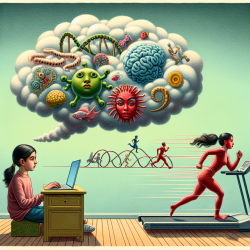Introduction
In the realm of speech-language pathology, understanding the dynamics of learning and adaptation is crucial. The research article "Host-parasite Red Queen dynamics with phase-locked rare genotypes" offers insights that can be applied to improve therapeutic outcomes for children. This study explores the complex interactions between hosts and parasites, shedding light on evolutionary dynamics that could be mirrored in educational and therapeutic settings.
Understanding Red Queen Dynamics
The Red Queen hypothesis describes a situation where species, such as hosts and parasites, coevolve in a way that maintains a balance, preventing any one species from becoming dominant. This is akin to the challenges faced in therapy where children and therapists must continuously adapt to new strategies and techniques to achieve progress.
Applying Evolutionary Concepts to Therapy
In the study, researchers discovered that certain genotypes remain rare and phase-locked, while others dominate in cyclic patterns. This finding can be metaphorically applied to therapy, where certain approaches may be more effective at different times or for different individuals. By understanding these dynamics, therapists can tailor their approaches to better meet the needs of each child.
Key Takeaways for Practitioners
- Adaptive Strategies: Just as genotypes adapt to environmental pressures, therapy strategies should be flexible and responsive to the child's progress and challenges.
- Individualized Approaches: Recognize that what works for one child may not work for another. Tailor interventions to the unique needs of each child, much like how different genotypes respond to evolutionary pressures.
- Continuous Evaluation: Regularly assess the effectiveness of therapy techniques and be willing to adjust them, similar to how organisms adapt to maintain balance in their ecosystems.
Encouraging Further Research
The study's findings encourage further exploration into how these evolutionary dynamics can inform therapeutic practices. By investigating how adaptive strategies can be optimized, practitioners can enhance their ability to support children's development effectively.
Conclusion
By drawing parallels between evolutionary biology and speech therapy, practitioners can gain valuable insights into creating more effective, adaptive, and individualized therapy plans. Embracing the complexity of these dynamics can lead to better outcomes for children, fostering their growth and development in a supportive environment.
To read the original research paper, please follow this link: Host-parasite Red Queen dynamics with phase-locked rare genotypes.










